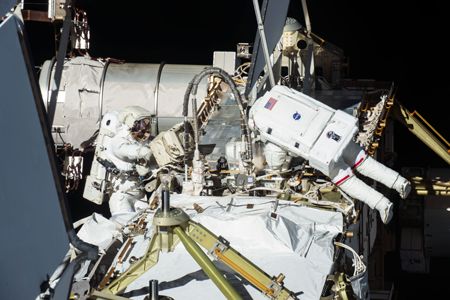
TIME FOR A WALK
SCOTT KELLY AND KJELL LINDGREN STEP OUTSIDE TO TACKLE MUCH-NEEDED UPGRADES TO THE SPACE STATION

Scott Kelly takes his second space walk on Expedition 45.
A SPACECRAFT THAT KNOWS HOW TO repair or maintain itself hasn’t been built yet. That’s especially problematic when the one in question is the International Space Station—which is larger than a football field, weighs nearly 1 million pounds, and required more than 100 different spaceflights just to get its components into orbit and properly assembled. After 15 years of continuous occupancy, the ISS was in need of one of its periodic upgrades, and on November 6, astronauts and first-time spacewalkers Scott Kelly and Kjell Lindgren stepped outside for the first of two scheduled space walks to perform some much-needed work.
That space walk—or EVA (extravehicular activity), in NASA’s preferred parlance—involved basic electrical work, with Kelly and Lindgren running new cables along parts of the station’s length to provide power for docking ports that will be needed when new commercial crew and cargo vessels begin arriving in 2017. The astronauts also installed a thermal cover on a scientific instrument to protect it from the extreme temperatures of space, and they lubricated portions of the ISS’s robotic arm.
If that sounds like awfully undramatic, low-tech work, it’s because it is. Build the most sophisticated machine you want, but it still comes down to the nuts-and-bolts business of, well, nuts and bolts. Doing basic handyman work is radically different in space, however—and radically more dangerous. In 2013 Italian astronaut Luca Parmitano nearly drowned during a space walk when coolant water leaked into his suit and began flooding his helmet.
To reduce the risks and help ensure that the necessary work gets done, many of the basic protocols for any space walk are worked out far in advance of a mission, with practice sessions in NASA’s Neutral Buoyancy Lab (NBL), a 6.2-million-gallon swimming pool with a full-scale mock-up of much of the ISS resting on its bottom. But some of the details can’t be fully validated until the astronauts are already in space, which was true for Kelly, who went up far in advance of his scheduled walk.
Significant changes to the EVA plan are often beamed up to the crew first as simple PowerPoint-type animations. Finer points are worked out in the NBL and radioed up later in the most granular detail possible—the precise torque that has to be used to tighten a bolt and how many turns it will need before it’s secure, for example. The determination of which man does which job while they’re both outside is made by experience, skill set and a few other non-negotiable considerations.
Kelly, as the more senior of the two astronauts, was lead spacewalker for the first EVA, on October 28, which meant he was first out, last in, and generally in command throughout the exercise. His suit also had the red striping used to indicate the commander, which helps controllers identify who’s who as they follow the exercise from the ground. Nonetheless, for that walk, Lindgren was assigned some of the more challenging work in some of the trickier areas of the station. Why? “He has longer arms,” says NASA’s Grant Slusser, who was the ground director for the first EVA.

Kjell Lindgren (in all white) and Kelly (with red stripes at his knees) work on the P6 Truss to open the Photovoltaic Radiator Fluid Quick Disconnect Coupling on Nov. 9, 2015.

Kelly took this celebratory selfie on Oct. 28, 2015, during his first space walk. “Great first spacewalk yesterday,” he later tweeted. “Now on to the next one next week.”
The mere business of getting the EVA suits ready can be a days-long job. Cooling loops that run through the garments like a human circulatory system have to be flushed with water to remove any contaminants. And while each suit is precisely tailored to the astronaut who will wear it, what fits on Earth may not fit in space, for the simple reason that without gravity, the spine may elongate a bit.
It’s been more than half a century since cosmonaut Alexei Leonov became the first human being to walk in space, and in all that time the work hasn’t gotten appreciably easier or safer. But it hasn’t gotten less transcendent either. “You can hear your heart beat and you can hear yourself breathe,” Leonov told photographer Marco Grob in a story for TIME. “Nothing else can accurately represent what it sounds like when a human being is in the middle of this abyss.”